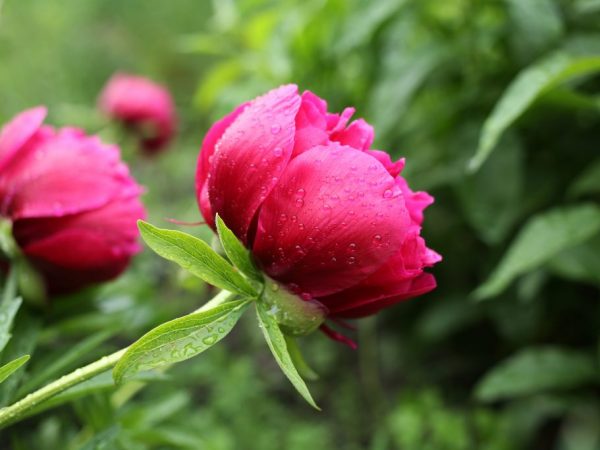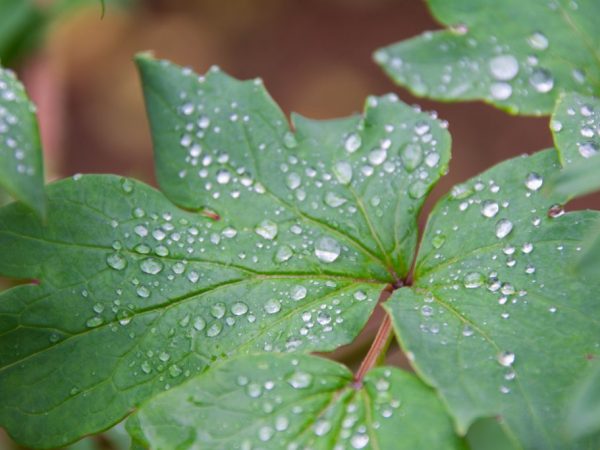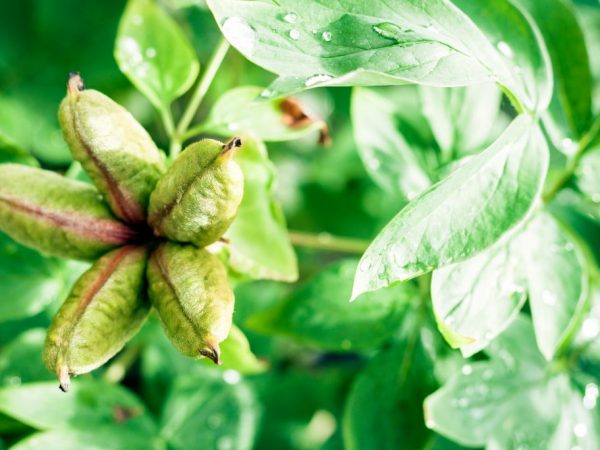Feeding peonies in the fall - terms and necessary components
Perennial flowers grow in the garden for several seasons and do not require replanting. These varieties include peonies - it is enough to plant them once in a permanent place and provide proper care. Consider how to feed the plants in the fall and how to do it correctly?

Feeding peonies in the fall - terms and necessary components
The purpose of autumn feeding
Peonies bloom actively during the summer season.
During the warm season, they give up almost all the accumulated substances for the growth and development of foliage and flowers, actively increasing the green mass. And even after intensive budding, perennial plants continue to develop their root system to prepare for the coming winter.
The main task of autumn feeding is to replenish the spent useful elements and provide adequate nutrition before the winter cold.
In the absence of nutrition, the quality characteristics of the culture deteriorate markedly: the inflorescences become not so large, become smaller, the leaves lose contrast, the duration of the flowering stage is reduced.
In autumn, peonies need three main components - potassium, phosphorus, nitrogen.
Be careful! During this period, an excess of nitrogen is very dangerous - this leads to unnecessary growth of green mass before winter and lowers the overall frost resistance of the plant.
Basic Rules
- Fertilize only those bushes that are 3 years old or more;
- If autumn is dry and warm, preference is given to liquid complexes; In the rainy season, granular mixes are better;
- For sandstones and depleted soils, top dressing is applied 2 times with a mandatory interval of 2 weeks;
- Alkaline and slightly acidic soils are fed with superphosphates in order to improve the quality characteristics of the soil layer;
- Organic and potassium-phosphorus formulations are applicable for every type of soil.
Terms of introduction
Fertilizers are applied taking into account the age of the flower and regional characteristics of cultivation. The optimal dates are from the first half of September to mid-October.
It is worth being guided by a long-term weather forecast, so that the completion of the work takes place 30-45 days before the arrival of frost.
When peonies breed in the fall, feeding should be completed by mid-September, so that the root system has time to get stronger before the onset of a cold snap.
More often, gardeners divide food into 2 conditional periods:
- Before pruning, in the first half of September, when replacement buds are formed in the culture, from where stems will grow in the spring next season. The preferred diet is minerals.
- After pruning, when only 2-3 cm stumps remained on the bush.At this stage, it is better to use organic matter.
How to feed
Organic

Organic fertilizers increase soil fertility
The main type of fertilizer preferred by gardeners for a natural basis and the absence of toxic effects on the plant itself and on the soil.
Organic matter not only nourishes flowers, but also increases the fertility of the soil and its structure.
| Time | View | Rules and dosage |
| September-October, once | Mullein | Fresh cow dung (10 l) is dissolved in water (50 l), ash (0.5 kg) and superphosphate (0.2 kg) are added. The mixture is left to ferment for 2 weeks. The standard for the preparation of an aqueous working solution is 1: 2. Watered under the bush, avoiding contact with the root collar. Consumption rate for 1 plant - 10 liters. |
| September-October, once | Compost | Dry foliage, tree branches, herbaceous vegetation, weeds, vegetable tops are suitable. All ingredients are left to rot in a specially equipped pit. To improve the quality of organic fertilizer, layers are shifted with a small amount of droppings, peat or humus. Aged compost is mixed with soil and spread 3-5 cm under a flower. Such a nutritious layer will not only serve as natural nutrition, but will also warm the peony roots. Mulch is laid on top - hay, straw or dried grass. |
| September-October, once | Chicken droppings | Chicken droppings (5 l) are diluted with water (120 l). The mixture is left to ferment for 2 weeks. The standard for the preparation of an aqueous working solution is 1: 3. Watered under the bush, avoiding contact with the root collar. Consumption rate for 1 plant - 10 liters. |
| September-October, twice, with an interval of 2 weeks | Rye bread | A loaf of rye bread (it is possible to replace 0.5 kg of rye crusts) is poured for 0.5 days until it swells completely. Porridge is diluted in 10 liters of water at room temperature and poured with a mixture of peonies. The consumption rate of the working fluid per plant is 1 liter. In a two-week interval, it is allowed to use mineral fertilizers. |
| September October | Wood ash | Consumption rate - 100 g for every 1 m² of flower plantings. Pour along the perimeter of the bush growth site, followed by mulching. Bone meal added to it in a 1: 1 ratio will help to increase the efficiency of ash feeding. |
| September-October, once every 4-5 years | Peat | For flowering species, high-moor peat is shown. Fertilize by laying around the flower at the rate of 10 liters per 1 m² of plantings. |
| September-October, once | Biohumus | The dosage is 5-6 kg of fertilizer per 1 m². |
| September-October, once | Organic preparations Baikal, Bio-master, AgroProst. | The dosage is according to the instructions. Suitable for infertile soils, clay and loamy soils. |
| September October | Siderata | Frost-resistant mustard, oats, wheat or rye are planted near the place of growth of peonies in the fall, burying them in the spring in the soil layer for subsequent reheating. |
Mineral components

Fertilizers prepare the bush for winter
For feeding peonies, they successfully use ready-made mineral fertilizers or use a combination of the main components required in the fall for perennial flowers - potassium and phosphorus
| Time | View | Rules and dosage |
| September October | Phosphorus potassium in liquid form | Dissolve the ingredients in a 1: 1 ratio in water at room temperature and water the flowers. The consumption rate of the working fluid per bush is 10 liters. |
| September October | Phosphorus potassium in dry form | For each bush 20 g 15 g. The ingredients are mixed together, poured into pre-formed holes up to 6-8 cm deep with moistened soil, avoiding the root collar. After adding minerals, the peonies are watered. |
| September October | Tablet ready-made preparations Kemira-kombi Kemira-autumn | 1 tab. 10 liters. The plants are watered with the working solution. Consumption rate for 1 bush - 10 liters. |
Summing up
Autumn feeding of flowering perennial varieties, which include peonies, is simply necessary. Fertilizers restore to plants the lack of nutrients spent in the process of active flowering, and prepare the bush for the winter cold.
You can feed the peony family with ready-made mineral complexes or organics, observing the recommended dosages.

